Responses to Gender Bias and Discrimination among Women Officers
Col. Adrian “A. J.” Sullivan, U.S. Army
Allison Abbe, PhD
Download the PDF 
Four female four-star general officers gathered this year to commemorate Women’s History Month, representing women’s achievements in the Army, Navy, Air Force, and Coast Guard.1 The event was titled “Beyond Firsts” to highlight continuing progress with including women in the all-volunteer force. Lifting the combat exclusion for women in 2015 was an important milestone, and since then, representation of women at entry levels has increased in both the enlisted and officer corps. Women are now 17.6 percent of the active-duty military force overall and comprise 23.2 percent of active-duty Army lieutenants.2 These numbers reflect incremental progress toward Department of Defense (DOD) goals for the Strategy on Women, Peace, and Security, aiming to exemplify “a diverse organization that allows for women’s meaningful participation across the development, management, and employment of the Joint Force.”3
Women’s integration into ground combat roles has been accompanied by policy changes to accommodate greater gender diversity and changing family patterns. The Army and other services have implemented career intermission programs that enable career breaks for family, caregiving, or other personal goals that service members may find difficult to fit into active-duty service. More recently, the 2022 publication of Army Directive 2022-06, Pregnancy, Postpartum, and Parenthood, represents an important step in supporting parenthood without requiring breaks in service.4 In other gender-inclusive steps, the Army’s updated grooming standards are more responsive to feedback from women soldiers and officers.5
Nonetheless, women officers currently serving have already experienced the impacts of previous, less inclusive policies in their careers. Current field-grade officers entered service prior to lifting the combat exclusion, and many started families before the 2019 National Defense Authorization Act relaxed some of the constraints on officer career timelines—for example, authorizing officers to take a career intermission of up to three years.6 As a result, the strains of balancing family with deployments and other work demands have taken a toll. Retaining these officers is essential to provide junior women officers mentorship and leadership models and shift organizational cultures to be more welcoming to women. Previously recognizing the importance of women leaders, the Army implemented a “leader first” policy toward gender integration into combat specialties.7 Other occupational specialties are no different; the advancement and recognition of women leaders serve as necessary signals of a path to success in the organization to more junior women.
After years of stalled progress, the Army is again showing increases in women’s representation. From fiscal years (FY) 2004 to 2012, women’s representation in the active-duty Army declined from 15.3 percent to 13.6 percent, until resuming an upward trend and reaching 15.3 percent again in FY 2019.8 Maintaining those gains, women were 15.5 percent of the active-duty Army in FYs 2020 and 2021.9 The officer corps has shown more steady but small increases in women’s representation, from 16.7 percent of active-duty Army officers in FY 2004 to 19.3 percent in FY 2019.10
Because women’s educational achievement has outpaced men’s in recent years, women will continue to be an important source of manpower for the Army in meeting its end-strength requirements.11 Unfortunately, women do not enter service at proportions approaching their representation in the U.S. population, let alone their rates of high school graduation for enlisted or bachelor’s degree achievement for officers. For example, as of 2021, of adults twenty-five years or older who held a bachelor’s degree, 53.1 percent were women, while 46.9 percent were men.12
Nor do women stay as long. Past research by the Government Accountability Office (GAO) has shown that women service members are 28 percent more likely than their male counterparts to separate from service, though differences have narrowed in recent years.13 Similarly, the 2021 Workplace and Gender Relations Survey found that women officers reported lower intentions to stay in the service than male officers, assuming they have the opportunity: 50 percent of women versus 58 percent of men among company-grade officers (O-1–O-3) and 67 percent of women versus 72 percent of men among field-grade officers (O-4–O-6) intended to stay.14
Although women are more likely to separate than men, promotion rates show mixed outcomes.15 Overall, GAO found that women officers were promoted at slightly higher rates than male officers from 2004 to 2018. However, controlling for time in service and other demographic factors, GAO’s analysis found lower promotion rates for women field-grade officers in the Army. Thus, women officers’ career progression in the military differs from men’s. Their lower entry and higher attrition relative to male officers appear to reflect decisions to self-select away from the Army, at least at career stages prior to field grade.
Women officers are leaving voluntarily for a variety of reasons. GAO identified six reasons for the higher attrition among women service members, including the impact of work schedules on families, deployments, organizational culture, family planning, sexual assault, and dependent care. Three of these contributors (work schedules, deployments, and dependent care) specifically related to balancing caregiving roles with work demands. In contrast to these persistent challenges, others are more punctuated through a career. Family planning considerations focused on the incompatibility of timing pregnancy around key career milestones, such as command, in-resident education, or training pipelines. Many of these concerns have since been addressed through the Army’s Parenthood, Pregnancy, and Postpartum directive and other initiatives, though it will take time to identify the impact on women’s career decisions.
Other contributors to attrition remain. Sexual assault was identified as contributing to attrition in at least two ways: first, the experience itself may be traumatic, and the second is the organizational and peer response to the sexual assault. Effective responses do not erase the trauma of an assault event but can be instrumental in a survivor’s recovery, just as effective medical care is critical to a soldier or officer’s recovery from physical injury. Ineffective responses can contribute to a persistent state of injury without recovery. Other research has provided quantitative evidence of the role of sexual assault and sexual harassment in increasing women service members’ attrition. A 2021 RAND report estimated that for sexual assaults and harassment occurring in FY 2014 alone, the DOD lost ten thousand additional service members in the subsequent twenty-eight months than would be expected from other causes of attrition.16 Although this estimate includes both men and women, it disproportionately impacts women due to the higher percentage of women service members who experience sexual assault and sexual harassment. Both the experience of a sexual assault and the organization’s response in the aftermath may signal to service members that the military is not a safe and supportive work environment. Service members expect to confront risk in operational settings but may be less willing to accept organizational indifference to or tolerance of threat and risk from other service members.
GAO also identified organizational culture as contributing to women’s attrition through various means, including a lack of women role models and mentors, experiences of sexism and discrimination, and exclusion from professional networks. Organizational culture tends to be more stable and resistant to change than other organizational features.17 Although the Army promotes a formal set of values, many cultural assumptions may be informal and less visible, sometimes operating beneath leaders’ awareness. For example, the Army’s history of low gender egalitarianism sustains a masculine organizational culture, and the impact on women can range from subtle exclusion to open hostility and discrimination.18 These behaviors occur as individual acts, but their prevalence may indicate a climate or culture of acceptance.
Today’s Army may reflect a legacy culture of hegemonic masculinity, a set of assumptions accepting and promoting social dominance of men over women.19 Under hegemonic masculinity, women are valued in a subordinate status, and positioning women as equals or as leaders will elicit attempts by some men to reassert their dominant status via behaviors like hostility, harassment, or even sexual assault toward women.20 More benign forms of this gender hierarchy are evident in recent survey results. The 2021 Workplace and Gender Relations Survey included an instrument to assess sexism, and Army officers (O-1–O-6) showed statistically significant gender differences on all items (e.g., “Women exaggerate problems they have at work”), except one item on beliefs about moral superiority of women over men.21 Though sexist beliefs were endorsed by a minority of respondents, male officers showed more agreement with sexist beliefs, including both hostile sexism and more “benevolent” sexism that promotes the protection of women. These beliefs certainly do not reflect Army values but rather are likely a byproduct of historical societal values, the Army’s hierarchical structure, and a historically male-dominated population.
Over their careers, women officers currently serving have experienced the progression in more inclusive policies. Nevertheless, more inclusive policies may not be sufficient to remedy the effects of past gender-exclusive unit climates and cultures and persistent gender hierarchies. Retaining women officers is critical to achieving goals of the Army People Strategy, and it is therefore important to understand women officers’ perspectives and experiences.22 Many previous studies have focused on women officer retention in the Navy, Air Force, and Coast Guard.23 However, few studies have examined the experiences of women officers in the Army. The present study gathered women officers’ experiences of gender, both positive and negative, to identify how women officers navigate minority status and gender stereotypes in a male-dominated profession.
Method of the Study
The present study recruited participants through sampling the first author’s contacts and through women officers’ mentorship groups on social media. Research participants were given the option to conduct a personal interview, phone call, Teams video chat, or receive the questions over email and answer them at their leisure, returning them within a few weeks. All except one participant were emailed the questions and opted to provide written answers to the questions, with one participant conducting a Microsoft Teams video chat with transcribed conversation.
Respondents had an average of 17.4 years of service, ranging from two to thirty years. Of forty-four respondents, forty-two were Active Component Army officers and two were from the Reserve Component. Eight respondents either had retired or were planning to retire within the year. Their ranks included three first lieutenants, four captains, thirteen majors, twenty lieutenant colonels, and four colonels. Occupational branches included twenty-four in logistics; five in adjutant general; four in military police; three in aviation; two each in medical services and civil affairs; and one each in military intelligence, chemical, signal, and acquisition.
Due to space constraints, findings reported in this article are a subset of the larger study; other results will be published in a subsequent article. This article focuses on three items from the broader interview protocol: respondents’ reasons for joining the Army; whether and why they had considered separating from the Army; and lastly, if they could tell the top-ranking general in the Army one thing about how to address women officers’ experiences, what would that be?
Reasons to Join
Many respondents indicated multiple reasons for joining the Army (as a result, the percentages below do not add to one hundred). Two respondents did not answer the question about why they had joined the Army. No differences emerged between company-grade and field-grade officers.
The most common reason for joining was to pay for college (40.5 percent). Appeal of the jobs or structure was another common reason for joining; twelve respondents (28.6 percent) indicated they were attracted by the job security, variety of jobs, travel, leadership opportunities, or the opportunity to avoid boredom. A few respondents mentioned that they preferred Army career paths over those of the Air Force or Navy.
Twelve respondents (28.6 percent) indicated family service motivated them to join. Most responses stated a parent’s service was a model, but some indicated it was a sibling or a parent who served as a DOD teacher that inspired their service. One indicated she was motivated to make her family proud.
Purpose was the fourth most prevalent category of reasons. Over a quarter of respondents (26.2 percent) mentioned their patriotism drove them to serve or indicated a sense of purpose, service, or calling. Several mentioned a desire to be part of something bigger than themselves. Two responses specified their aspiration to make a difference.
Less frequently, respondents mentioned opportunities to play sports at the U.S. Military Academy or a desire to make a better life. Only one respondent mentioned a reason for joining related to gender, which was that she had engaged with a female officer role model (other than a parent) as an adolescent.
Overall, women officers’ reasons for joining the Army were similar to other reports on propensity to serve. In the 2022 Joint Advertising, Market Research and Studies Futures Survey on youth propensity to serve, young women reported a propensity to serve somewhat lower than young men (8 percent vs. 12 percent) but reasons were similar.24 Reasons for youth propensity include to pay for education; to gain experience, skills, or travel; and to help others. One difference is that, in the present study, respondents frequently indicated purpose, whereas the Futures Survey specifies pay and benefits to a greater extent than our respondents indicated. Purpose emerged as a motivator as often as did family service among this sample. These findings are consistent with the 2021 Department of the Army Career Engagement Survey (DACES), in which the opportunity to serve one’s country and purpose were among the top five reasons to stay in the Army, selected as frequently as pay and benefits.25
Although some differences may be due to the officer sample here versus the broader youth population of potential enlisted and officers, findings suggest perhaps recruiting should highlight purpose and calling to serve with greater prominence.
Reasons to Separate
In addressing whether they had considered getting out of the Army, most respondents provided more than one reason to consider separating. Only one officer responded “no,” and one officer provided no response. No clear differences emerged in reasons given by company-grade officers versus field-grade officers, though field-grade officers provided more reasons overall than did company-grade officers. The most frequent responses were family considerations and negative experiences with leaders. Sixteen respondents (36.4 percent) indicated parenting, marital relationship, spouse employment, or other family caregiving as considerations for separating. Three of these responses included specific comments about the challenges of balancing dual-military relationships. Two respondents indicated that they had declined command due to parenting demands.
- “I wanted to get out because of the struggle between being a good mother and a high performing officer. My children became latch key kids; I felt that I did not have the time to be involved in my children’s lives.”
- “I had concerns about raising a family while on Active duty … I am dual military and did not think I’d be able to balance all of the demands.”
- “I think about getting out when I get worried about the lack of stability I provide my children. I think about how they’ve never been in the same school for more than two years (most recently they have only been at a school for one year before having to relocate). So, I think about getting out when I consider that perhaps my sacrifices cost too much for my family.”
These reasons were consistent with DACES findings that both male and female active-duty service members endorsed family reasons as the top reasons to leave the Army, including effects of deployments on relationships and the impact of Army life on their significant other or children.26 However, on that survey, women endorsed these family reasons to a greater degree than male service members.
Sixteen respondents (36.4 percent) indicated their experiences with leadership were a consideration for separating, including working for toxic leaders, having a poor working relationship with a supervisor, and seeing homogenous leaders in top roles.
- “While serving in [a special operations organization] my supervisor was probably the worst officer I have ever worked with. He grew up in Special Mission Units and did not have much experience working with women, so I knew working for him would be a high adventure. Coupled with his narcissistic, egotistical, and selfish behavior, it was tough to work for him.”
- “In 2010 I considered leaving the Army because of a combination of family issues and discrimination I was facing at work. The unit I was assigned to had widespread and well-known gender discrimination that started with the BN Commander and was an issue at all echelons. Females were regularly openly ridiculed, not placed in career enhancing positions, ignored in meetings, barred from attending outside meetings, rumors spread about them, and a variety of other things.”
- “The pentagon is full of retired senior officers who continue to influence/advise senior leaders in an outdated theory of policy and priorities. That sounds extremely cynical, and I am not. The senior DACs in the pentagon were extremely valuable in mentorship, however the population was homogenous.”
Thirteen respondents (29.5 percent) specifically indicated experiences with gender discrimination or bias as reasons to separate. Some examples that respondents described overlapped with the leadership issues, noting impacts on mental health.
- “I dealt with so much from discrimination to harassment to toxic leadership that I was convinced that even if I changed units, I’d inevitably run into one of those situations again. My mental health could not take any more feeling like I was worthless, a terrible officer/Soldier, and the depression and anxiety that came with it.”
- “Yes, several times. The first time was in Afghanistan when my company commander found out about a SGM sexually harassing me and did absolutely nothing about it except to tell me to ‘keep my head down.’”
Five respondents indicated that organizational culture or climates motivated them to consider separating, noting “hostile environments” and “toxic culture.” One respondent explained, “We are expected to serve unconditionally and not question anything. ... We are expected to do more with less.” According to another respondent, “They can make all the programs and resiliency training they want but nothing has changed because once that program falls to the wayside we revert to the ‘Good ol’ Boys Club.’”
Five respondents identified shortfalls in pregnancy or postpartum recovery accommodations as a consideration, and others indicated experiences with racism and sexual assault. Other reasons were not necessarily gender-related, such as six field-grade officers who indicated dissatisfaction with opportunities for advancement or with job opportunities as they moved up in the ranks. Three respondents mentioned other opportunities outside of the Army as a consideration for separating. Three officers specifically indicated the operational tempo or deployments.
These reasons are largely consistent with the findings of the GAO study, but one notable difference is that leadership featured more prominently in the present research. Future DACES and studies of officer retention should address this dimension in greater granularity, as it may provide one explanation for gender differences showing lower morale among women.27
Although not specifically asked why they remained in service, some respondents explained without prompting. These responses identified positive aspects of the job as a key motivator, such as making positive change for soldiers, and one response was that “rewarding days always outweigh the hard days.” Other, less frequent responses included financial considerations, retirement benefits, and knowing when an assignment in a unit with discrimination or poor climate would end.
How Should Top Army Leaders Address Gender Bias?
All respondents provided recommendations in response to the question asking how the top general in the Army should address women’s gendered experiences in the Army. Officers’ recommendations not only identified gaps but also actions that had had a positive impact on their own careers. Responses indicated the seven themes as clear and concrete actions that Army senior leaders can implement.
1. Acknowledge and listen. Encouraging Army senior leaders to better understand the challenges that women officers face was by far the most prevalent theme, with 43.2 percent of respondents offering recommendations in this category.
- “First, recognize that this problem still exists. Benign and subtle sexism is just as bad as blatant or hostile sexism.”
- “Stop saying that discrimination doesn’t exist or give the younger generation the tools to deal with it and overcome. I came in believing we were equal, and the uniform made us all the same. Not anymore.”
- “Listen to and take seriously women’s concerns and input. I think that ‘Big Army’ is doing a lot to combat and eliminate gender discrimination. I think that it’s at the unit-level where culture needs to change.”
- “Women are not equals in this Army. This is a man’s Army that women participate in versus the U.S. Army that has both men and women.”
2. Increase women’s representation in leadership. The second most prevalent theme was to increase women’s representation in leadership positions, though it was a distant second with 16 percent of respondents. Responses identified the benefits for women’s representation in improving unit climate, opportunities for female mentorship, visibility of role models for junior women, and broadening perspectives for problem-solving. In addition, some responses indicated women leaders might have a deterrent effect on sexist behavior.
- “Representation matters. When female senior leaders are present, juniors don’t feel emboldened to discriminate against junior officers, NCOs and enlisted.”
- “Place women in higher and more visible positions of authority in FORSCOM units would also help in creating a safer environment for all Soldiers.”
- “Having more women in positions of leadership makes a huge difference; I didn’t meet a female field grade in my branch until I was a company commander but have since then been the beneficiary of mentorship from several senior women. Having more women in positions of leadership normalizes it and socializes the force into treating women the same as their male counterparts.”
3. Increase accountability. A few respondents (11.4 percent) indicated that the Army should better hold leaders accountable for counterproductive behavior.
- “Do not allow any leaders to behave in a manner that is demeaning or discriminatory towards anyone; females, males, minority groups, etc. If a leader is producing results at whatever level of command but they are doing it in a toxic manner, then they must be removed. Yes, toxic leaders usually get results but at the cost of their Soldiers’ morale.”
- “If a leader is getting bad feedback or if you hear that a leader is no good—get them out of the Army, stop promoting them because they only get worse.”
4. Improve talent management. Responses related to talent management (11.4 percent) identified opportunities to select officers for developmental assignments and education more fairly and to make performance evaluations more objective. Two responses indicated that studies and analyses of trends would be beneficial to determine whether disparities exist.
- “I think HRC [Human Resources Command] has done a good job of diversifying traditional broadening opportunities (e.g., JCS [Joint Chiefs of Staff] internship, Congressional Fellowship, etc.). I think we can do better where the senior commander (a GO) is picking their team (e.g., executive officers, SIGs, other front office folks).”
- “We need to honestly review the difficult data. Disparities in leadership positions, opportunities, wording throughout evaluations, retention, promotions, and recruitment.”
- “Weed out comments and adjectives about female leadership through command climate surveys or leadership assessments that have negative connotations for women but are perceived as notable or commendable for men. For example, a women described as ambitious is a criticism, but an ambitious male equates to driven with initiative.”
5. Strengthen male leadership and ownership. Some respondents (11.4 percent) identified the importance of male leadership in modeling respectful and inclusive behavior. Most of these responses focused on positive and proactive behaviors; however; one respondent noted that male leaders might fear mentoring women due to the potential for gossip about their relationship. This issue also came up in some examples for considering separating from the Army, the harmful effects of unfounded rumors about romantic relationships between women officers and other team members or leaders.
- “Respect starts at the top, so if higher leaders are always disregarding women, the problem will spread downward from there.”
- “I would encourage them to consider having men more involved in female integration programs. While this may seem counterintuitive, I think at times women can self-segregate into these female-led groups, which is fine but I also think it can be detrimental … We should open these forums to men to educate them on how to break these generational stereotypes.”
- “Leadership is critical to treatment of women and building a team. My first group of leadership were very weak and very resistant to anyone who didn’t look like them, so it is no surprise that women were never fully accepted to the team. We were objects or tokens. The second group of leaders were better and my last group of leaders (BN/BCT CDR) were excellent and I did not face discrimination based on gender.”
- “I also think the culture needs to change that it is ok for males to speak to females without there being the stigma that they must be in a relationship.”
6. Improve and/or sustain policy and resourcing. Four respondents (9 percent) indicated that the Army should improve or sustain programs and policies that support women and parents, including funding child development centers and sustaining parental leave policies.
- “I would tell the General to PLEASE continue to ENFORCE the training and engagement of tools like the EO program, SHARP, and Assessment programs like BCAP, CCAP, etc., it is working—they are effective and I am a living witness (testament).”
- “Even if it means cutting funding to other programs, the Army must be willing to dedicate additional funds to remedying childcare shortages if they care about taking care of families and retaining those servicemembers with families who want to continue to serve.”
- “More women are having families while serving, which is made possible in part to the Army’s caregiver leave and postpartum policies. Continuing to support these types of policies that integrate women across the force and create an environment in which they can flourish as leaders will reduce discrimination, which ultimately increases readiness.”
7. Provide training to reduce gender discrimination and bias. Three respondents specified the need for training on discrimination and gender microaggressions, which are intentional or unintentional behaviors that exclude or denigrate individuals based on their gender.28 These behaviors are forms of gender discrimination but may be more subtle or ambiguous, and they represent earlier, more common behaviors along a continuum of harm.29
- “Top-down, thorough discrimination training. Specially to combat arms senior leaders. Senior leaders set the tone and culture for their organization. If senior leaders are lax or apathetic towards discrimination (in this case gender, but all types), their subordinates will feel more comfortable to display discriminatory behaviors. Microaggressions will escalate into more aggressive, obvious discrimination.”
- “We need to implement a lesson on Microaggressions in our EO training and make it required training in all PMEs.”
Respondents acknowledged gender bias is a societal and generational problem, and they did not expect it to disappear in their lifetimes.
Summary and Conclusions
The present study examined women officers’ experiences of gender in the Army and recommendations to build a more gender-inclusive culture. Their reasons to join were very similar to other findings on propensity to serve and were largely unrelated to gender. In this sample, women officers identified paying for college, job reasons, family history, and a sense of purpose as their primary motivations. Their reasons for considering separating were varied. Some reasons were consistent with findings from DACES, indicating that balancing family demands and personal relationships was challenging. These findings highlight the importance of policy and resources supporting parents and dual-military couples. Other reasons centered more on negative experiences with leaders, gender bias and discrimination, and organizational climates.
Respondents provided many constructive recommendations for Army senior leaders to continue progress in building a more gender-inclusive Army culture. Most prominently, women officers highlighted gaps in leadership and climate. They identified opportunities for Army senior leaders to increase their understanding of issues impacting women by listening to, assessing, and acknowledging women’s concerns beyond sexual assault alone. They described important roles for male leaders in holding others accountable for harmful behavior and greater engagement with women as peers and subordinates. Army senior leaders should continue emphasizing accountability in their priorities and objectives. By highlighting the importance of reducing these harmful behaviors, leaders at echelon will trust in their own decision-making skills to properly discipline violators and will know they are supported.
In talent management, women officers emphasized the importance of having more women in visible positions of leadership. They also called for increased transparency and fairness in talent management decisions such as developmental opportunities. For other organizational actions, they recommended increasing or sustaining policies and resources for families, and they saw the potential for training to reduce sexist behavior and promote positive climates.
True integration requires policy, organizational climate, and culture working in alignment. Policy alone will not reset organizational culture; it must be accompanied by intentional leader and organizational actions to embed a gender-inclusive culture through leader selection, performance evaluation, and other shaping mechanisms. The challenge is that while gendered experiences are driving women to separate, the Army needs them to stay to help break down historical gender hierarchies. Implementing the recommendations here and monitoring implementation of the new pregnancy and parental leave policies for their impacts will be critical to success in shifting toward a more gender-inclusive Army.
On the fiftieth anniversary of the all-volunteer force, the Army may be confronting an inflection point in women’s integration—will the Army build on positive policy changes and embed a more inclusive culture, or face stalled progress, leaving policy changes to do the heavy lifting in reshaping culture? In a competitive recruiting environment, the Army risks missing out on attracting and retaining women with the motivation to serve and the skills to lead. The Army of 2040 demands the Nation’s top talent; educated, trained, and fit women officers are a key investment in that future.
The views expressed in this article are those of the authors and research participants and do not necessarily reflect the official policy or position of the Department of the Army, Department of Defense, or the U.S. government.
Notes 
- Jonathan Lehrfeld, “Beyond Firsts: Female 4-Stars Discuss Changes for Women in Service,” Military Times (website), 7 March 2023, accessed 17 July 2023, https://www.militarytimes.com/news/your-military/2023/03/07/beyond-firsts-female-4-stars-discuss-changes-for-women-in-service/.
- “Table of Active-Duty Females by Rank/Grade and Service (as of October 2022),” Defense Manpower Data Center, accessed 18 July 2023, https://dwp.dmdc.osd.mil/dwp/app/dod-data-reports/workforce-reports.
- U.S. Department of Defense (DOD), Women, Peace, and Security Strategic Framework and Implementation Plan (Washington, DC: DOD, June 2020), accessed 17 July 2023, https://media.defense.gov/2020/Jun/11/2002314428/-1/-1/1/WOMEN_PEACE_SECURITY_STRATEGIC_FRAMEWORK_IMPLEMENTATION_PLAN.PDF.
- Army Directive 2022-06, Pregnancy, Postpartum, and Parenthood (Washington, DC: Headquarters, Department of the Army, 19 April 2022), accessed 17 July 2023, https://armypubs.army.mil/epubs/DR_pubs/DR_a/ARN35255-ARMY_DIR_2022-06-000-WEB-1.pdf.
- Army Regulation 670-1, Wear and Appearance of Army Uniforms and Insignia (Washington, DC: U.S. Government Publishing Office, 26 January 2021).
- Albert A. Robbert et al., Officer Career Management: Steps Toward Modernization in the 2018 and 2019 National Defense Authorization Acts (Santa Monica, CA: RAND Corporation, 2019).
- Kyle Rempfer, “Army Adjusts ‘Leader First’ Policy, Plans to Integrate Women into Last 9 Brigade Combat Teams This Year,” Army Times (website), 8 June 2020, accessed 17 July 2023, https://www.armytimes.com/news/your-army/2020/06/08/army-adjusts-leader-first-policy-plans-to-integrate-women-into-last-9-brigade-combat-teams-this-year/.
- Government Accountability Office (GAO), Female Active-Duty Personnel: Guidance and Plans Needed for Recruiting and Retention Efforts, GAO 20-61 (Washington, DC: GAO, May 2020), 51, accessed 17 July 2023, https://www.gao.gov/assets/710/707037.pdf; DOD, 2019 Demographics: Profile of the Military Community (Washington, DC: Office of the Deputy Assistant Secretary of Defense for Military Community and Family Policy [ODASD(MC&FP)], 2019), accessed 17 July 2023, https://download.militaryonesource.mil/12038/MOS/Reports/2019-demographics-report.pdf.
- DOD, 2020 Demographics: Profile of the Military Community (Washington, DC: ODASD[MC&FP], 2020), accessed 17 July 2023, https://download.militaryonesource.mil/12038/MOS/Reports/2020-demographics-report.pdf; DOD, 2021 Demographics: Profile of the Military Community (Washington, DC: ODASD[MC&FP], 2021), accessed 17 July 2023, http://download.militaryonesource.mil/12038/MOS/Reports/2021-Demographics-Report.pdf.
- Office of the Undersecretary of Defense, Personnel and Readiness, 2019 Population Representation in the Military Services (Arlington, VA: CNA, 2019), table D-19, accessed 17 July 2023, https://www.cna.org/pop-rep/2019/appendixd/d_19.html.
- “Fast Facts: Educational Attainment,” National Center for Education Statistics, 23 June 2022, accessed 17 July 2023, https://nces.ed.gov/fastfacts/display.asp?id=27; Richard Reeves and Ember Smith, “Boys Left Behind: Education Gender Gaps across the US,” Brookings Institution, 12 October 2012, accessed 17 July 2023, https://www.brookings.edu/blog/up-front/2022/10/12/boys-left-behind-education-gender-gaps-across-the-us/.
- U.S. Census Bureau, “Census Bureau Releases New Educational Attainment Data,” news release no. CB22-TPS.02, 24 February 2022, accessed 17 July 2023, https://www.census.gov/newsroom/press-releases/2022/educational-attainment.html.
- GAO, Female Active-Duty Personnel.
- Rachel A. Breslin et al., 2021 Workplace and Gender Relations Survey of Military Members: Active Component Results and Trends (Washington, DC: DOD Office of People Analytics, October 2022), 125, accessed 18 July 2023, https://www.opa.mil/research-analysis/health-well-being/gender-relations/2021-workplace-and-gender-relations-survey-of-military-members-reports/.
- GAO, Female Active-Duty Personnel, 32–34, 64.
- Andrew R. Morral et al., Effects of Sexual Assault and Sexual Harassment on Separation from the U.S. Military (Santa Monica, CA: RAND Corporation, 2021), accessed 18 July 2023, https://www.rand.org/pubs/research_reports/RR870z10.html.
- Leonard Wong and Stephen J. Gerras, “Culture and Military Organizations,” in The Culture of Military Organizations, ed. Peter R. Mansoor and Williamson Murray (Cambridge: Cambridge University Press, 2019), 17–32.
- Orna Sasson-Levy, “The Military in a Globalized Environment: Perpetuating an ‘Extremely Gendered’ Organization,” in Handbook of Gender, Work and Organization, ed. Emma Jeanes, David Knights, and Patricia Yancey Martin (Hoboken, NJ: Wiley-Blackwell, 2011), 391–411.
- Sarah Salvo, “The Effect of Hegemonic Masculinities on the Endemic of Sexual Misconduct in the United States Army” (master’s thesis, U.S. Army Command and General Staff College, 2021), 12, accessed 18 July 2023, https://apps.dtic.mil/sti/pdfs/AD1157470.pdf.
- Joshua Isbell, “Real Men: Countering a Century of Military Masculinity,” War Room, 1 March 2019, accessed 18 July 2023, https://warroom.armywarcollege.edu/articles/century-of-military-masculinity/.
- Breslin et al., 2021 Workplace and Gender Relations Survey of Military Members, 196–97.
- Ryan D. McCarthy, James C. McConville, and Michael A. Grinston, The Army People Strategy (Washington, DC: U.S. Department of Defense, October 2019), accessed 5 April 2023, https://www.army.mil/e2/downloads/rv7/the_army_people_strategy_2019_10_11_signed_final.pdf.
- GAO, Female Active-Duty Personnel.
- Joint Advertising, Market Research and Studies, “Spring 2022 Propensity Update,” (Washington, DC: DOD, 23 February 2023), accessed 18 July 2023, https://jamrs.defense.gov/Portals/20/Documents/YP52Spring2022PUBLICRELEASEPropensityUpdate.pdf.
- Loryana L. Vie, Eric V. Trivette, and Adam D. Lathrop, Department of the Army Career Engagement Survey, First Annual Report (Washington, DC: Headquarters, Department of the Army, June 2021), accessed 18 July 2023, https://talent.army.mil/wp-content/uploads/2021/11/DACES-Annual-Report_JUNE2021.pdf.
- Ibid.
- Ibid.
- Tessa E. Basford, Lynn R. Offermann, and Tara S. Behrend, “Do You See What I See? Perceptions of Gender Microaggressions in the Workplace,” Psychology of Women Quarterly 38, no. 3 (2014): 340–49, https://doi.org/10.1177/0361684313511420.
- Rachel Breslin, Ashley Klahr, and Adon Neria, The Continuum of Harm: Examining the Correlates of Sexual Assault Victimization (Washington, DC: DOD Office of People Analytics, September 2020), http://dx.doi.org/10.13140/RG.2.2.33546.90565.
Col. Adrian “A. J.” Sullivan, U.S. Army, is an active-duty logistician currently in brigade command of the Defense Logistics Agency Europe and Africa in Kaiserslautern, Germany. She holds a BA in criminal justice from Norwich University, an MA in logistics from North Dakota State University and is a recent graduate from the U.S. Army War College class of 2023 with a degree in strategic studies. Sullivan served in a myriad of traditional and tactical sustainment roles throughout her career to include a NATO assignment in Stavanger, Norway.
Allison Abbe is professor of organizational studies at the U.S. Army War College. Abbe previously served as a program manager and research psychologist in defense and intelligence organizations, and she holds a PhD in social and personality psychology from the University of California, Riverside. Her work has appeared in Parameters, Military Review, Joint Force Quarterly, and Police Practice and Research.

Invites You to Read More About Women in the Army
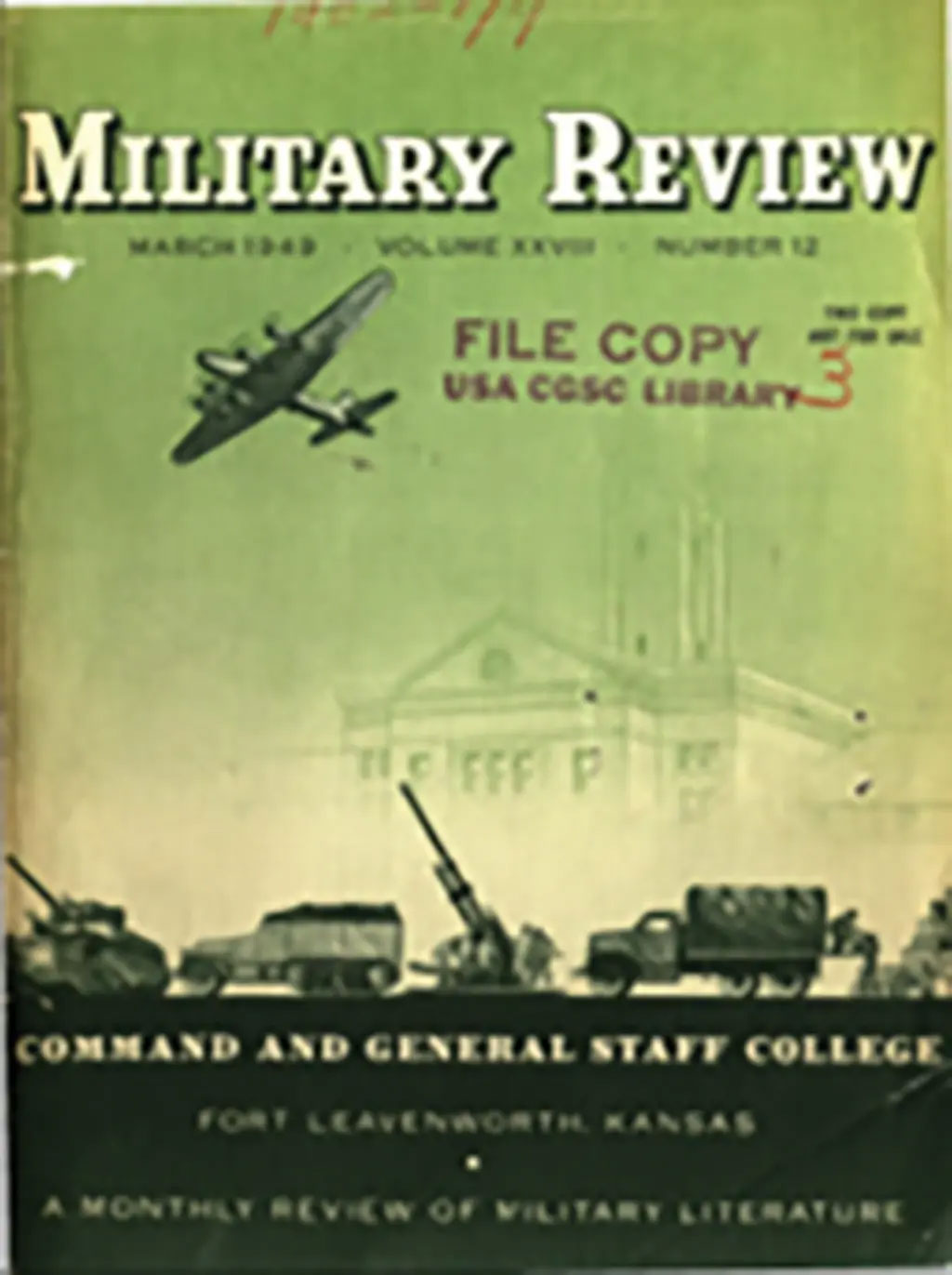
“The Women’s Army Corps Becomes Permanent,” Col. Mary A. Hallaren, U.S. Army (March 1949)
In the early days of the Women’s Army Auxiliary Corps, established on 14 May 1942, only four types of jobs were contemplated—clerical work, motor transport, cooking, and Aircraft Warning Service. Two years later, the corps extended its scope to include over two hundred different noncombatant jobs. The establishment of the corps as a part of the permanent military establishment is a tribute to the record of the corps in World War II, and to the need of women by the services in the future. https://www.armyupress.army.mil/Portals/7/military-review/Archives/English/100-Landing/Topics-Interest/Diversity-and-Integration/Mar-1949-Hallaren.pdf
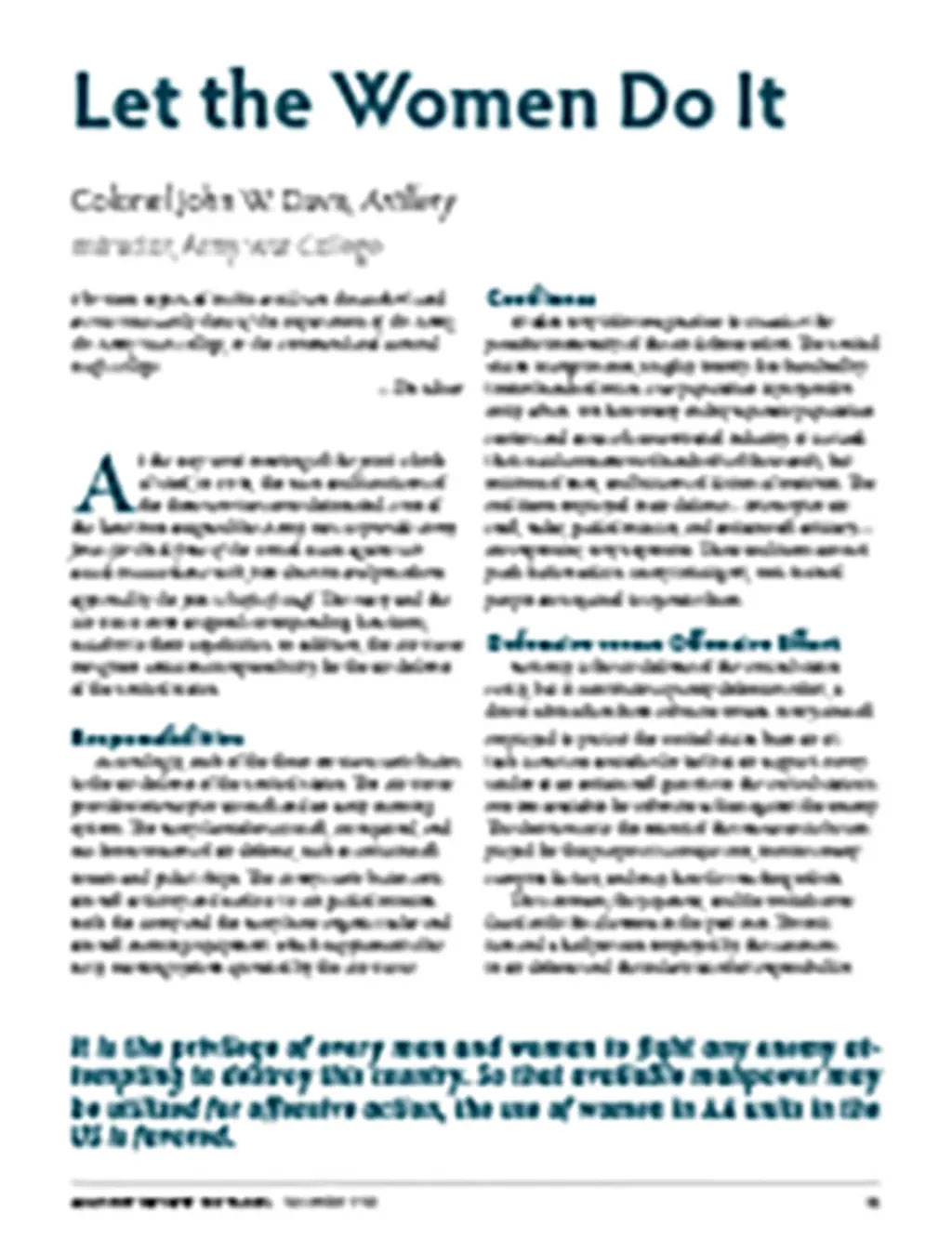
“Let the Women Do It,” Col. John W. Davis, U.S. Army (November 1951)
During the Atomic Age, air defense of the United States was considered a priority for the Armed Forces. The author recommends employing women in a homeland defense role to meet the Army’s high manpower requirement to accomplish this task. The role of women in the Army has been a topic of much discussion in Military Review over the years. https://www.armyupress.army.mil/Journals/Military-Review/English-Edition-Archives/January-February-2022/Davis-Let-Women-1951/
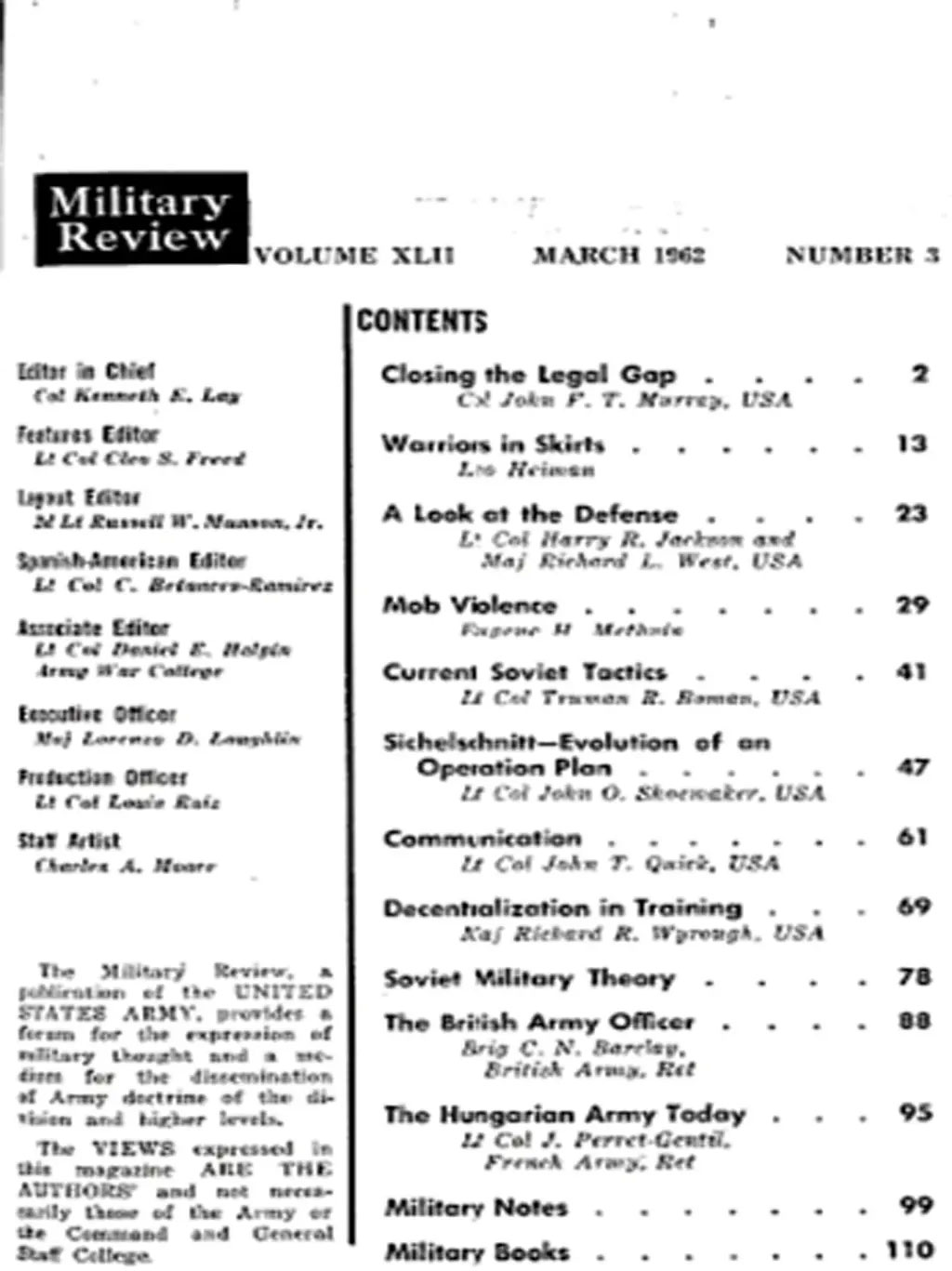
“Warriors in Skirts,” Leo Heiman (March 1962)
Critics were initially skeptical of women’s conscription; however, years of peacetime proved the misgivings were unfounded. https://cgsc.contentdm.oclc.org/digital/collection/p124201coll1/id/680/rec/5
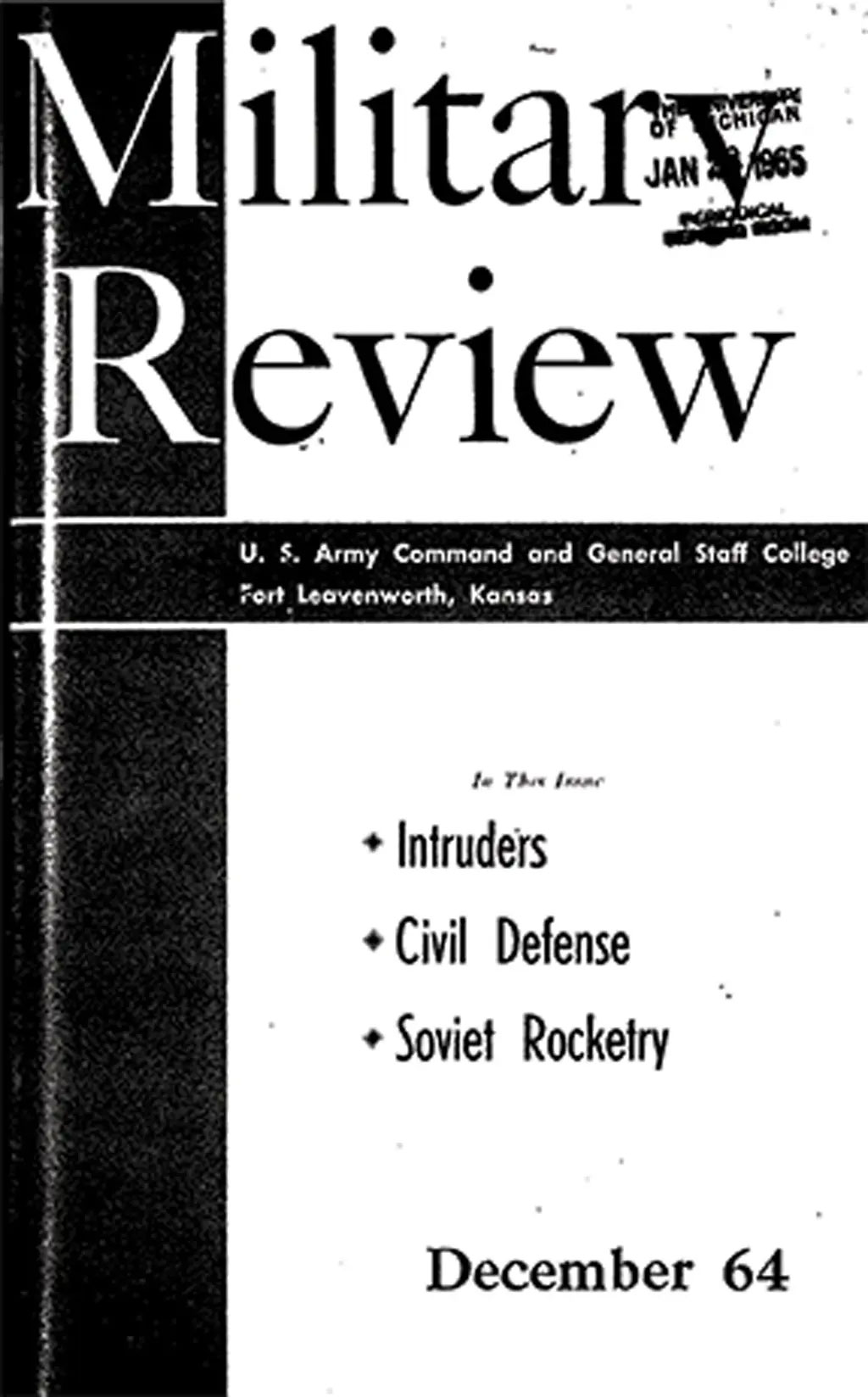
“The Intruders,” Maj. Reginald Hargreaves, British Army, Retired (December 1964)
In any future conflict of global dimensions, the distribution of the fighting formations would be far more diffuse, while the lengthy lines of communication would demand more and more men. This inordinate strain on manpower could only be met by the employment of more and more women. If past experience offers any criterion for the future, authorities can rest assured that the women’s response would more than keep pace with the demand. https://cgsc.contentdm.oclc.org/digital/collection/p124201coll1/id/662/rec/3
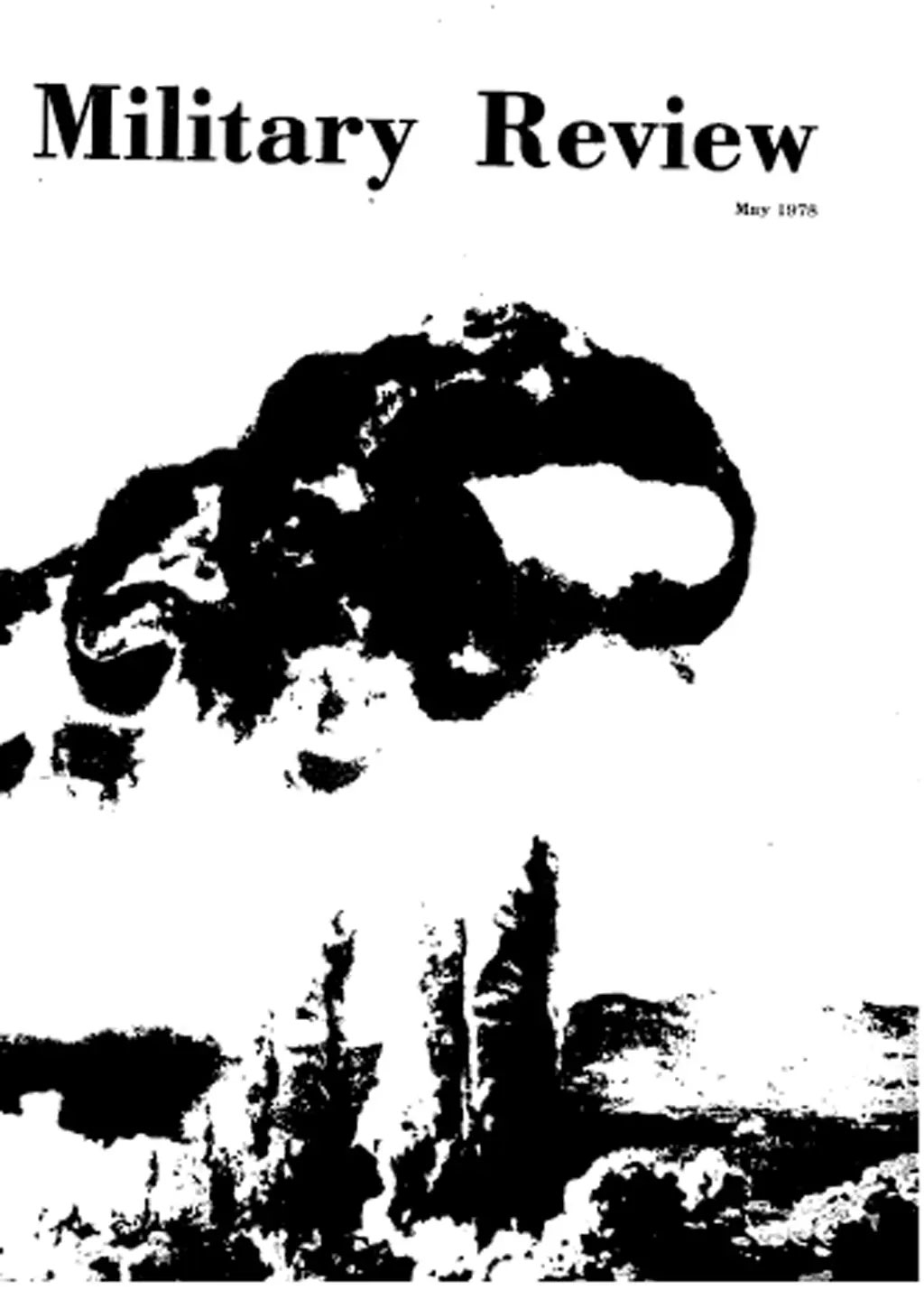
“Women in the Military: A Commander’s Perspective,” Lt. Col. Joel E. L. Roberts, U.S. Army (May 1978)
More and more women are being assigned to TOE units—a traditional male domain. Male commanders are not trained to cope with this sudden influx, and there are too few experienced female officers and senior NCOs available to assist the commander in dealing with the problems that arise. However, once the commander respects the fact that men and women are different, he also can expect the same professional standards and work performance from all his soldiers—male and female. The female soldier can be a definite asset if given a chance and understood. Isn’t it time we did? https://cgsc.contentdm.oclc.org/digital/collection/p124201coll1/id/377/rec/6
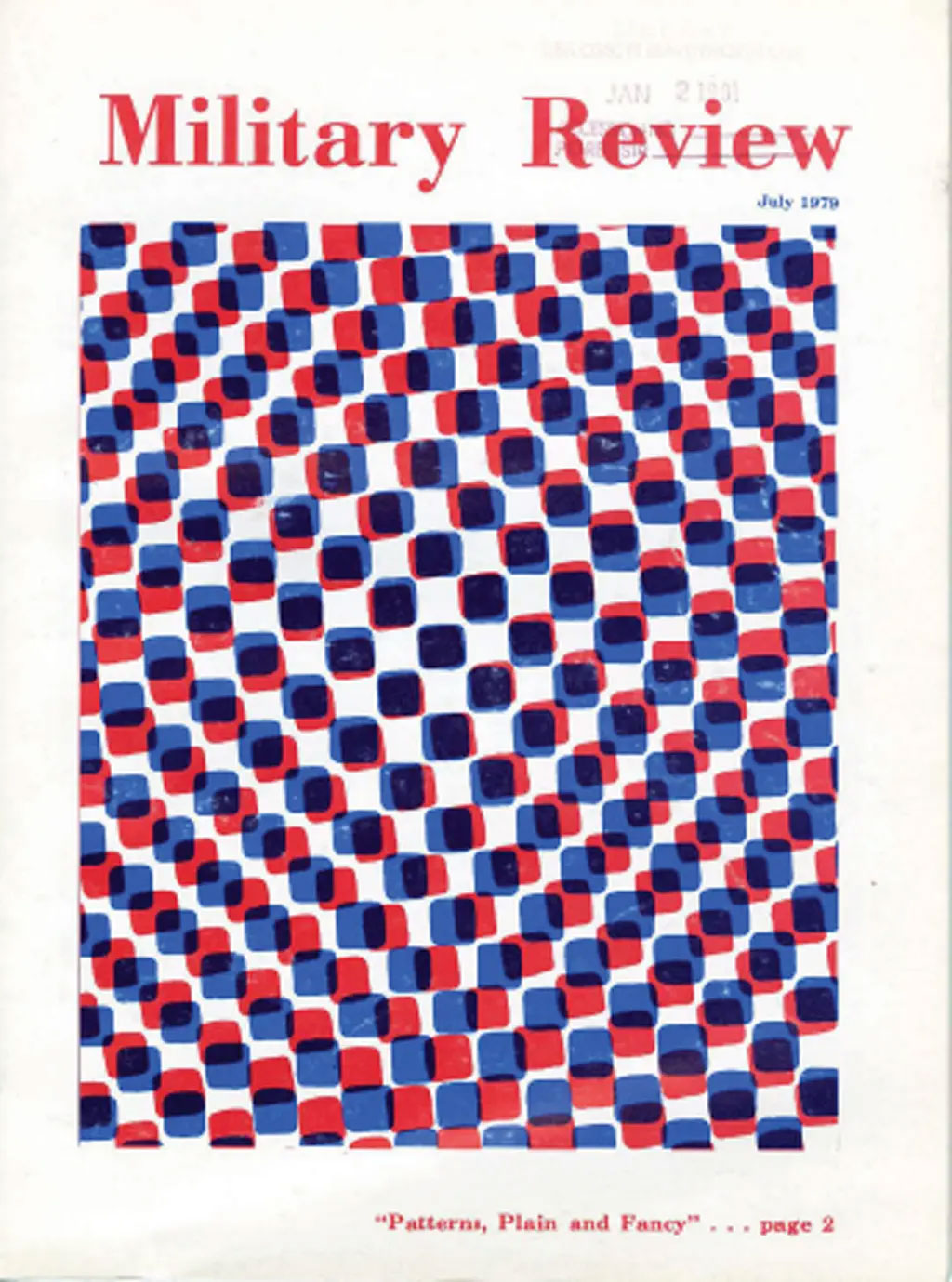
“Women in Combat?,” Maj. Michael A. Andrews, U.S. Army (July 1979)
Americans are proud of their civil liberties. “Human rights” have become international relations considerations. However, the mission of the profession of arms is combat, and equal opportunity does not exist within the military unless all jobs are available to all individuals qualified to perform them. Women remain relegated to support jobs in the Army, denied access to those jobs concerned with the Army’s raison d’être—ground combat. Further research and study have reached a point of diminishing return. The decision is difficult to implement and stabilization will be difficult. But this author feels an Army of a truly democratic society has no recourse than to put its women in combat. https://cgsc.contentdm.oclc.org/digital/collection/p124201coll1/id/1270/rec/11
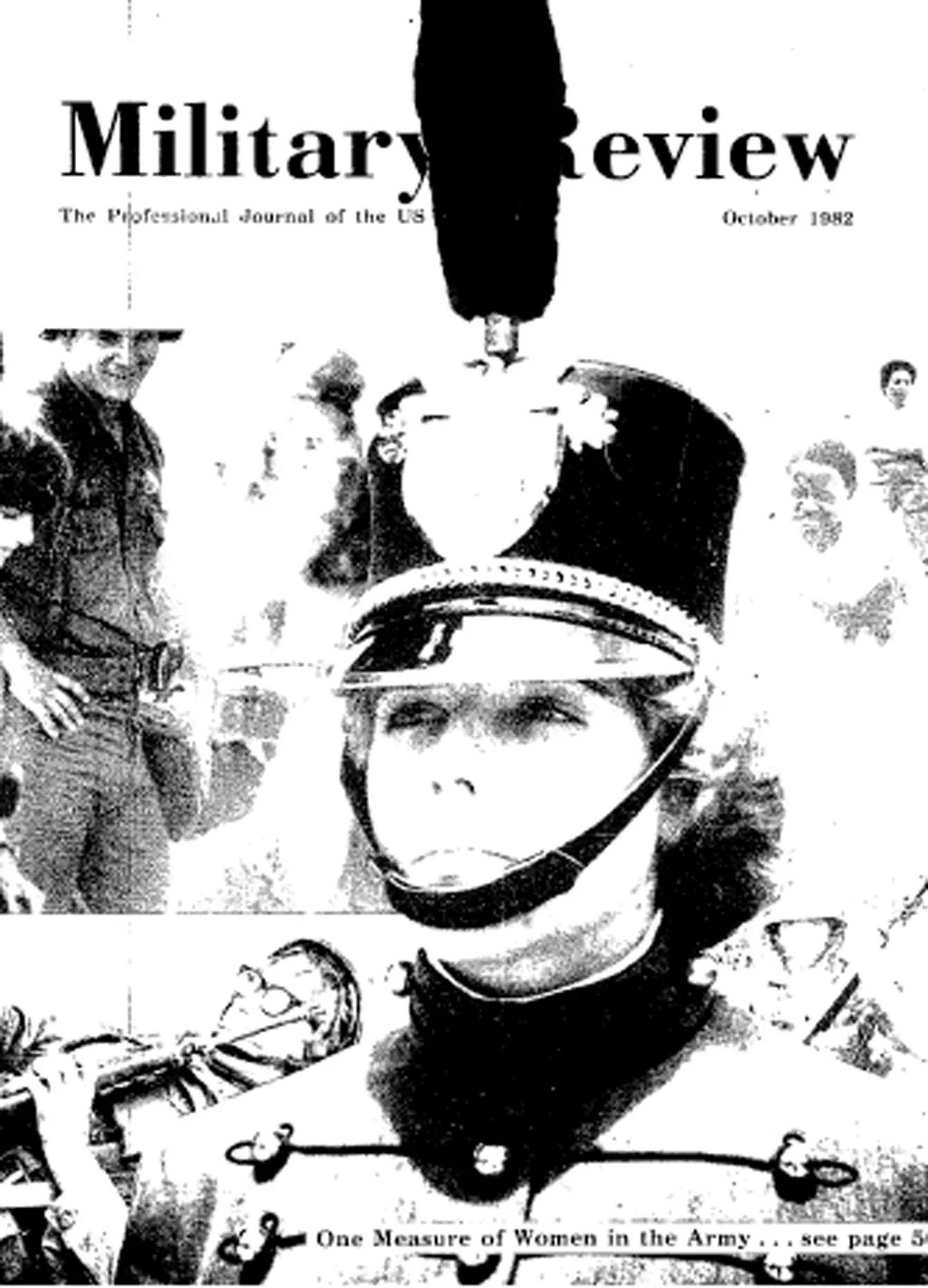
“Women in the Military: Do They Measure Up,” Maj. Robert L. Nabors, U.S. Army (October 1982)
The operational effectiveness of a military force depends upon a complex set of interrelated variables, none of which are more important than its people. Today, there is concern because of widespread perceptions that women represent a liability to the U.S. Army’s fighting capability. Specific concerns center on the lack of physical strength, pregnancy, and excessive lost-time rates, sexual harassment, and single parenthood. The author examines these areas of concern, draws some conclusions, and proposes actions he sees necessary. https://cgsc.contentdm.oclc.org/digital/collection/p124201coll1/id/311/rec/3
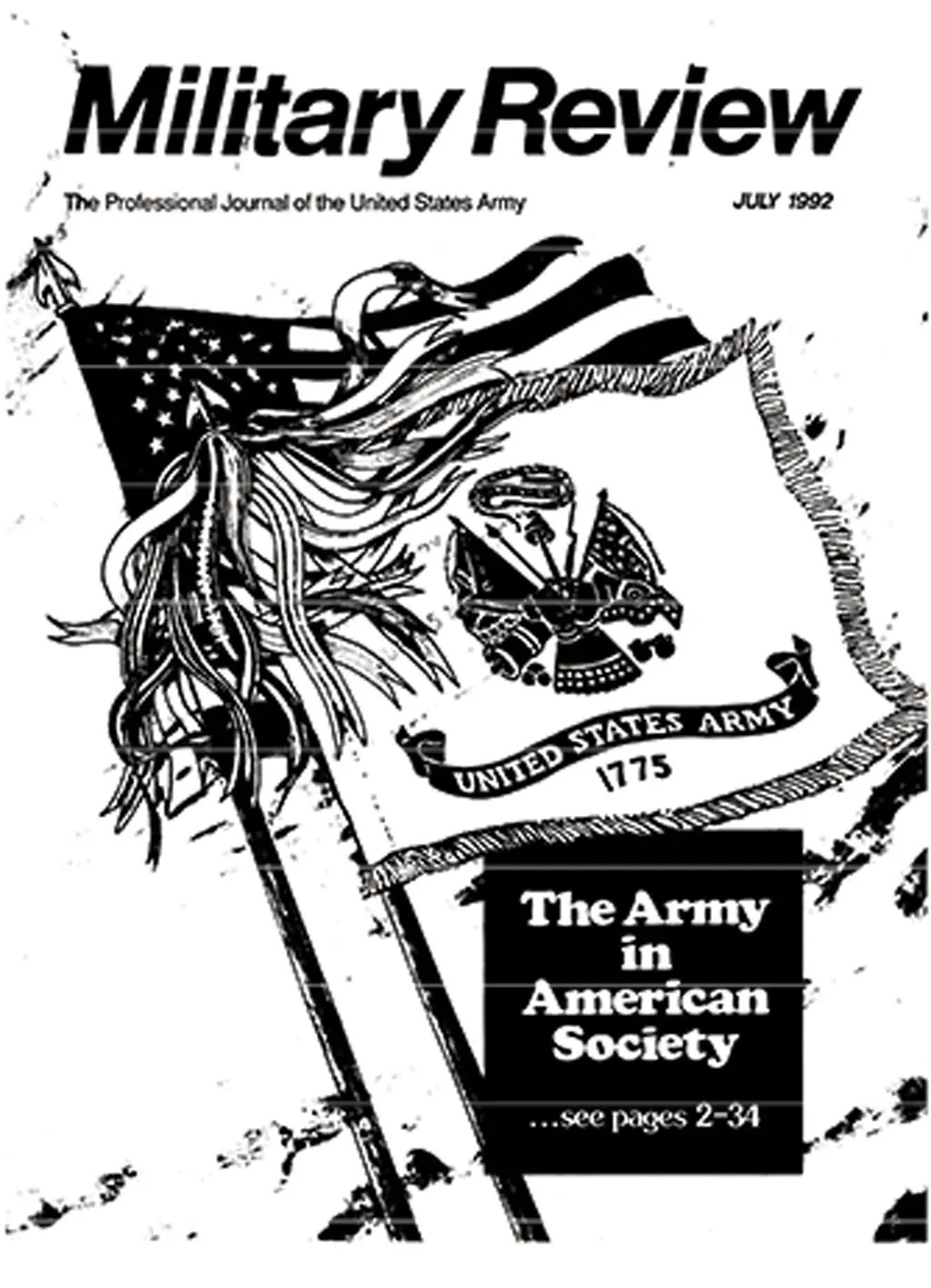
“The Future of Women in the Army,” Lt. Col. Robert L. Maginnis, U.S. Army (July 1992)
The role of women in the U.S. military has long been a controversial issue. In this discussion of gender-related issues, problems and possible remedies, the author addresses the questions of male resistance and limitations on career opportunities for female soldiers. He provides a historical background of current policy on women serving in combat units and offers recommendations to improve force readiness. https://cgsc.contentdm.oclc.org/digital/collection/p124201coll1/id/478/rec/11
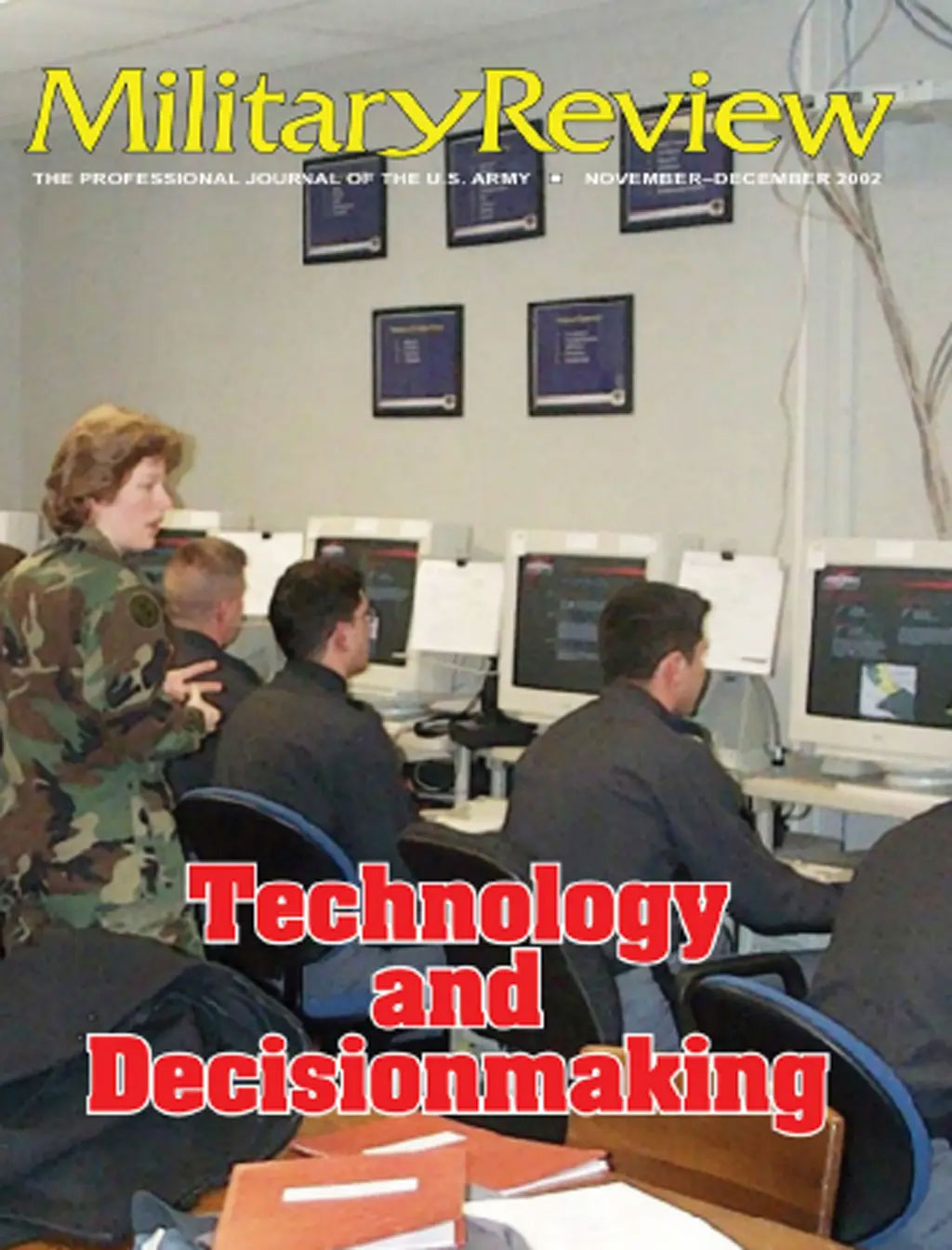
“The Female Infantryman: A Possibility,” Maj. M. Nicholas Coppola, U.S. Army; Maj. Kevin G. LaFrance, U.S. Army; and Henry J. Carretta (November-December 2002)
Nicholas Coppola, Kevin G. LaFrance, and Henry J. Carretta suggest an analytic methodology with which to examine the effect female soldiers might have on combat teams, particularly combat infantry units. https://cgsc.contentdm.oclc.org/digital/collection/p124201coll1/id/234/rec/5
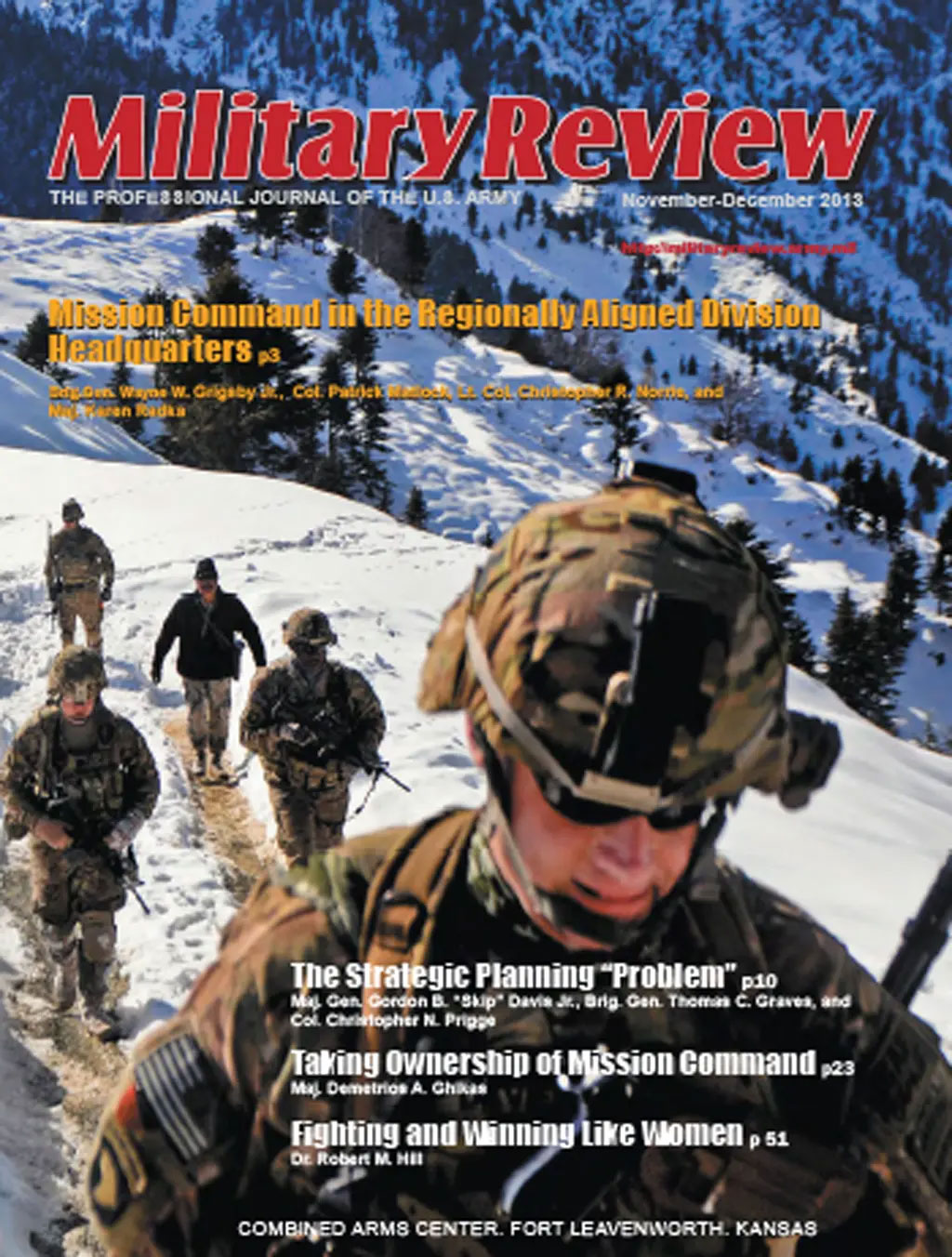
“Fighting and Winning Like Women,” Dr. Robert M. Hill (November-December 2013)
Success in the Army, or any military service, should not be determined by race, gender, sexual orientation, or even sexual identity but by one’s competence. https://www.armyupress.army.mil/Portals/7/military-review/Archives/English/MilitaryReview_20131231_art010.pdf
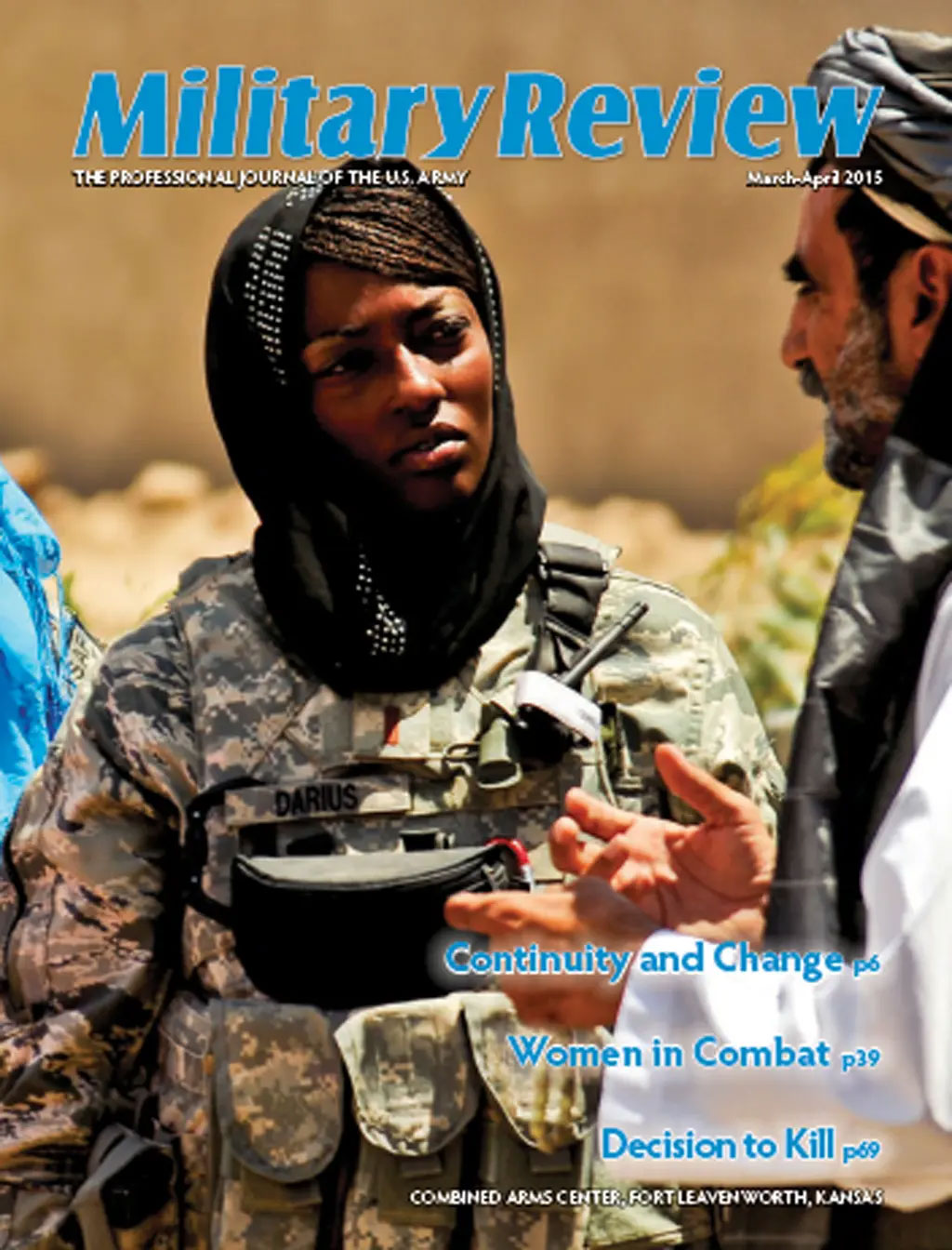
“Women in Combat: The Question of Standards,” Jude Eden (March-April 2015)
A former Marine opines that standards for combat-related military specialties are appropriately high and should not be lowered to allow for the inclusion of women into those occupations. https://www.armyupress.army.mil/Portals/7/military-review/Archives/English/MilitaryReview_20150430_art009.pdf
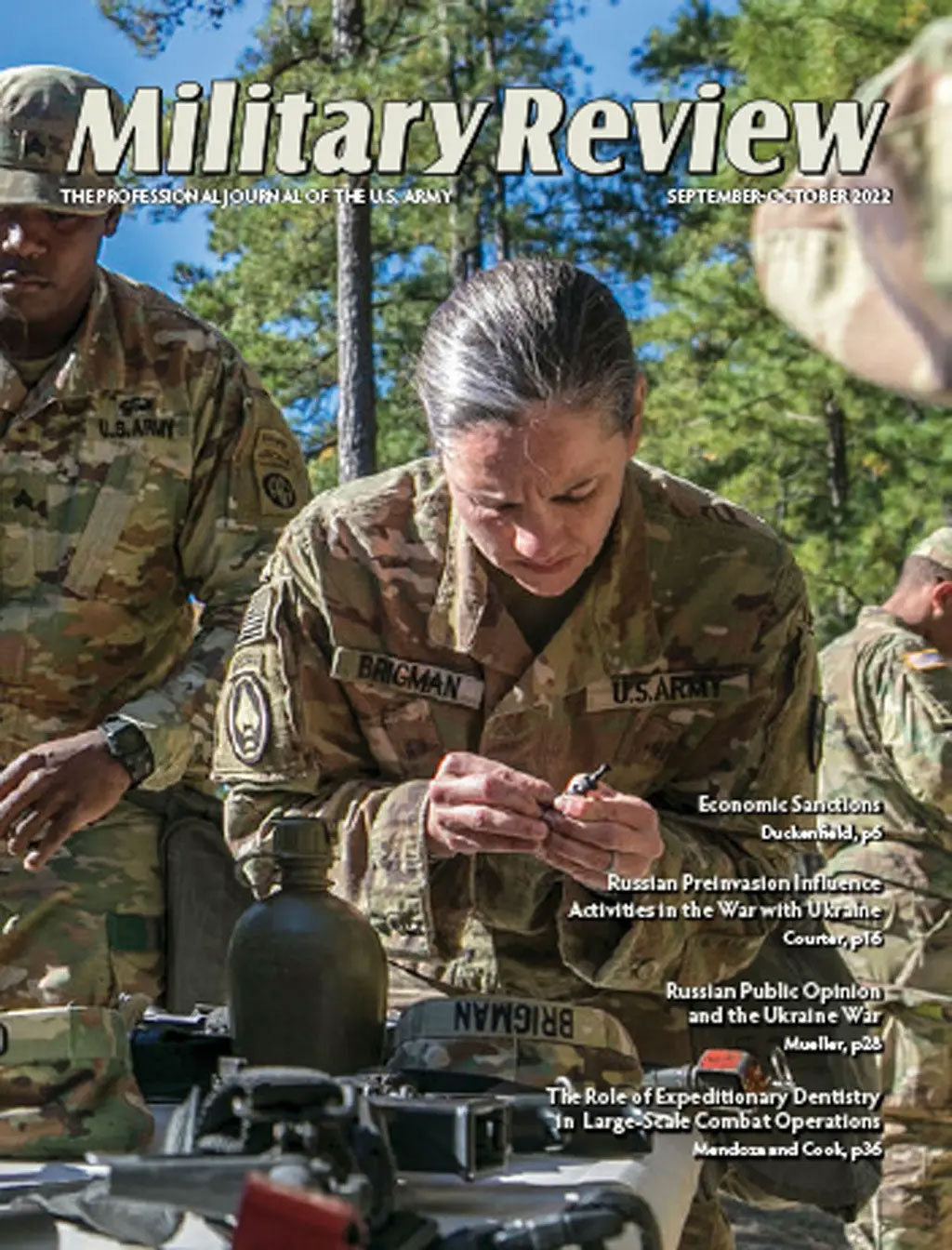
“Protecting Posterity: Women and the Military Selective Service Act,” Maj. Kelly M. Dickerson, U.S. Air Force (September-October 2022)
The draft enrollment system must include the whole of the American population to enable mobilization of 100 percent of able Americans instead of just 50 percent. Including women in a draft would provide the opportunity for both sexes to contribute fully to the national security of the United States. https://www.armyupress.army.mil/Journals/Military-Review/English-Edition-Archives/September-October-2022/Dickerson/
Back to Top